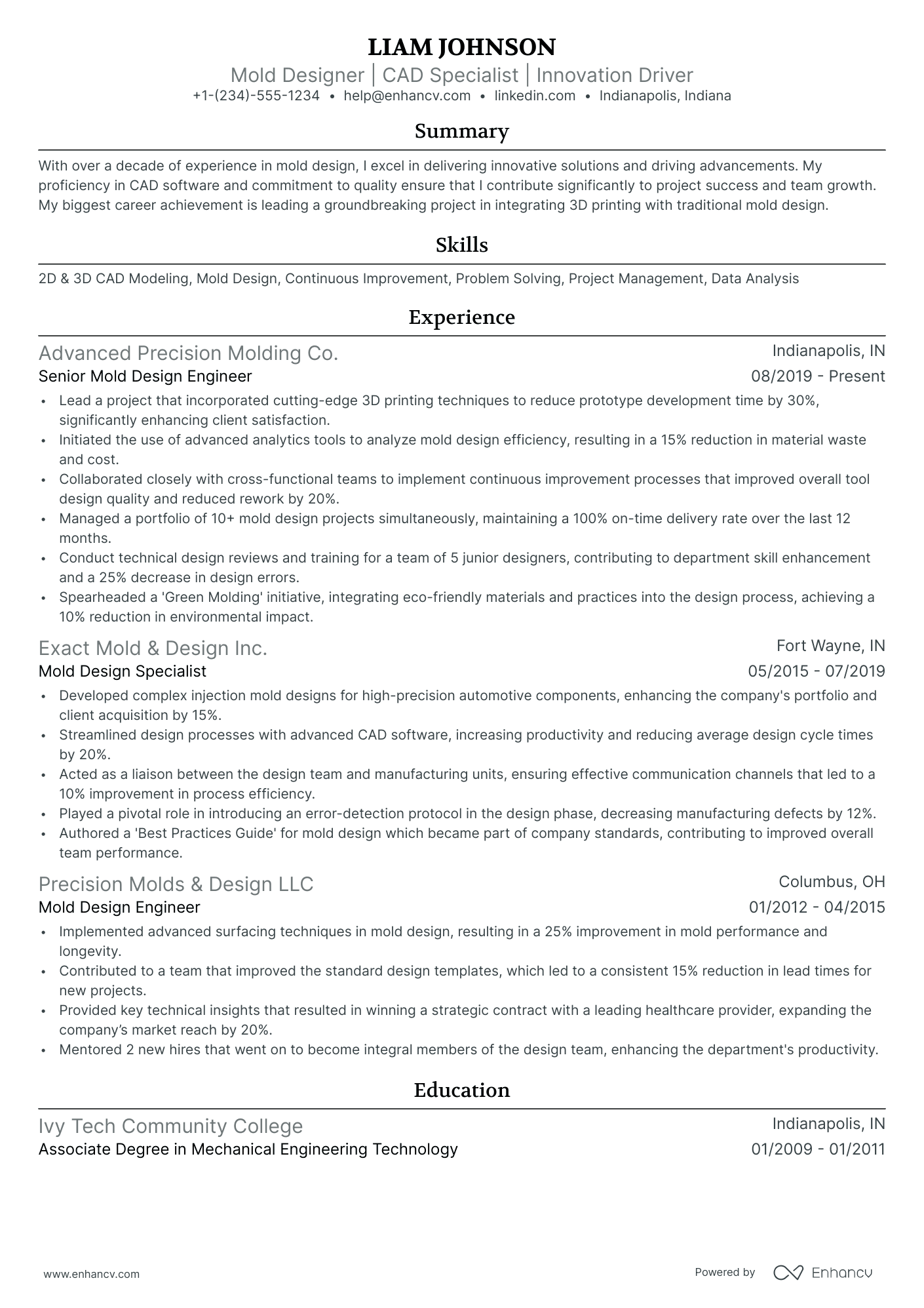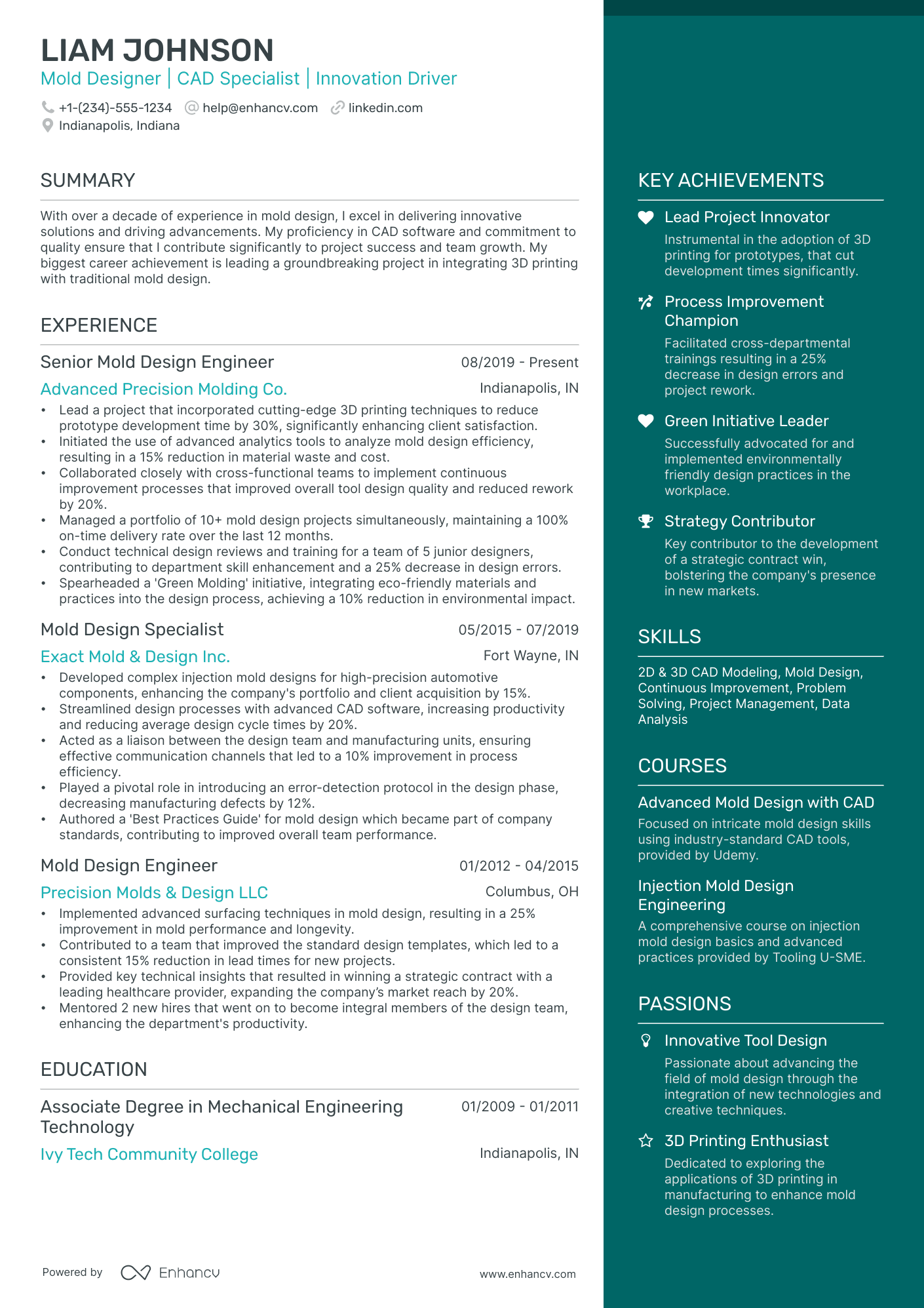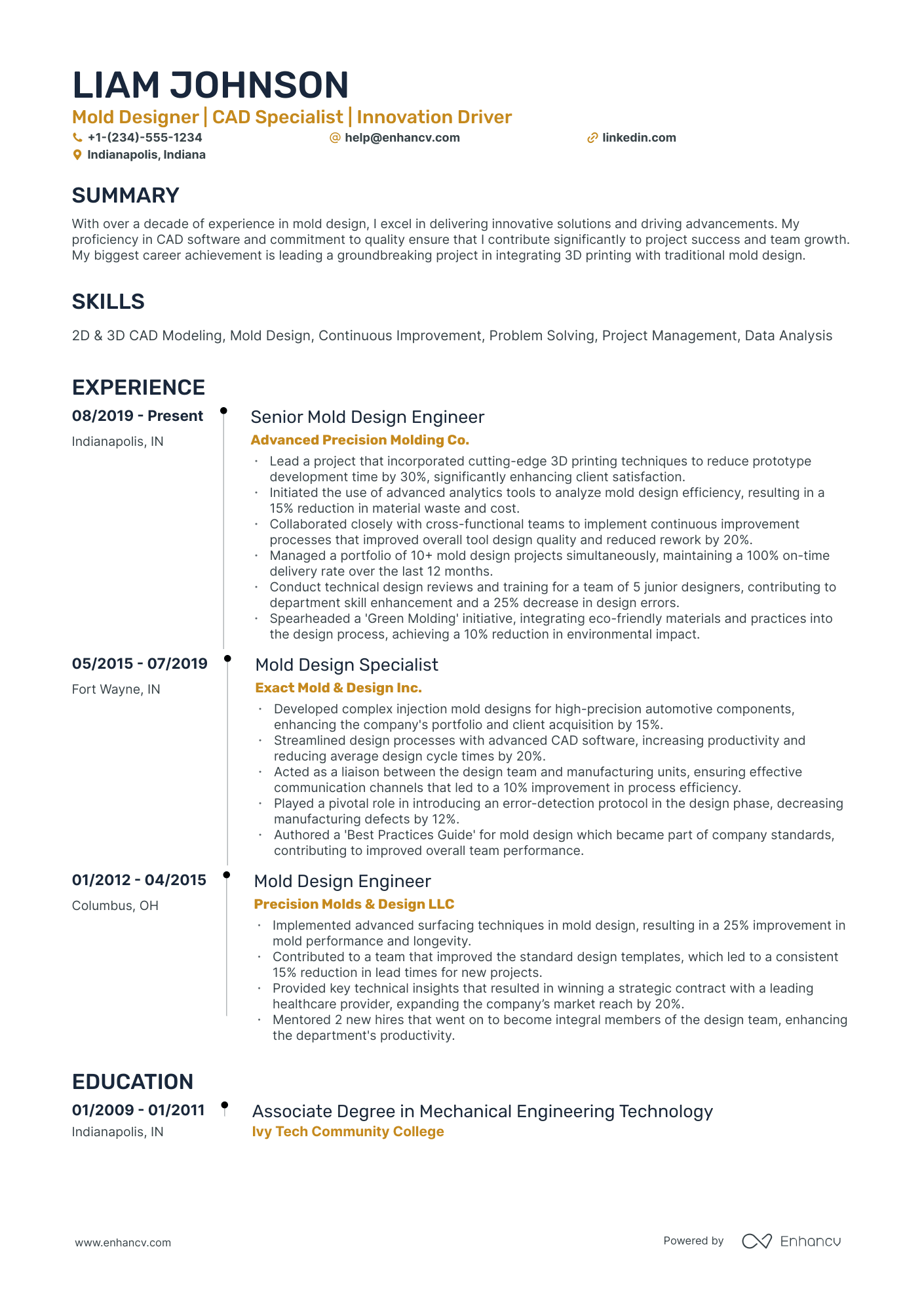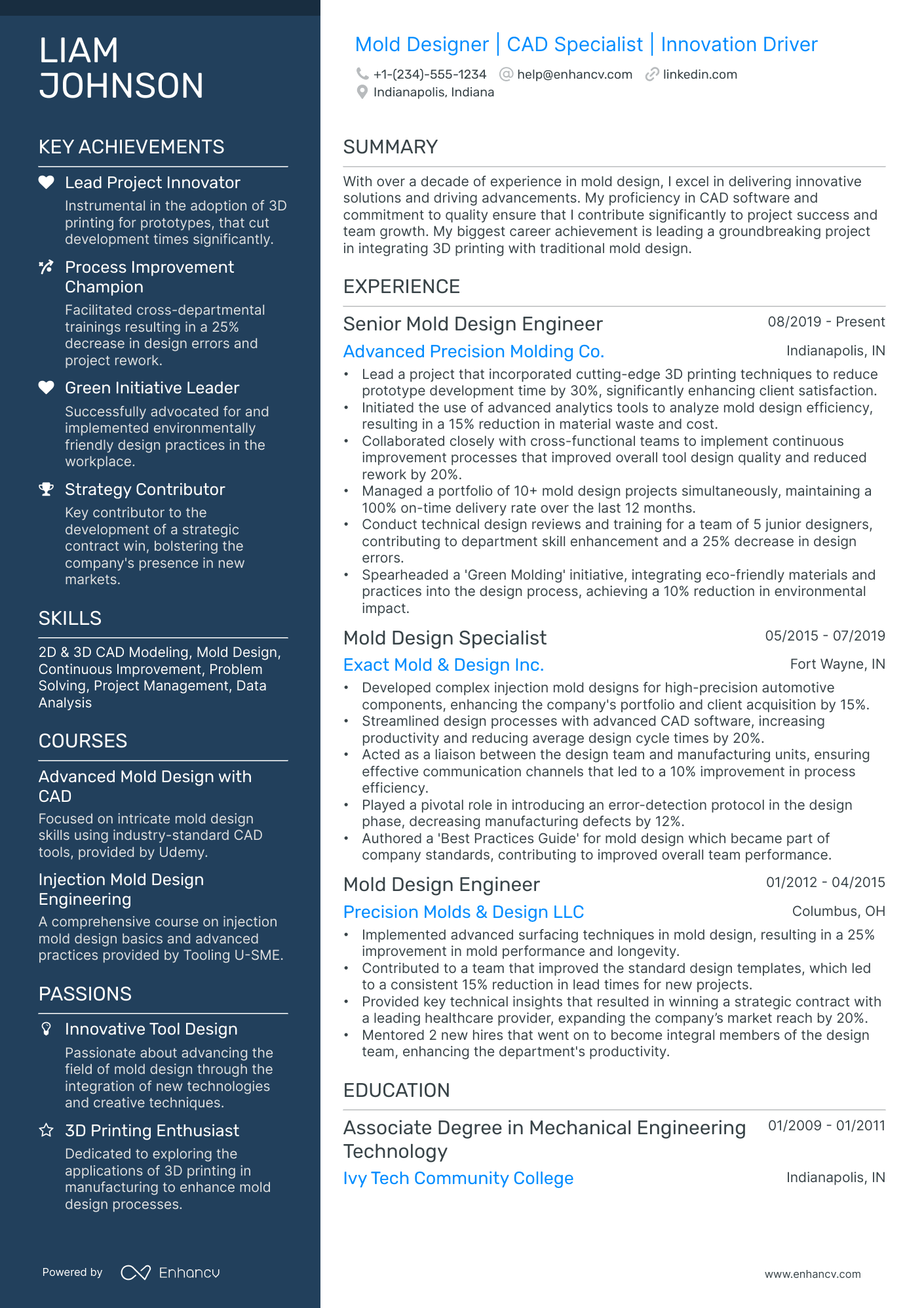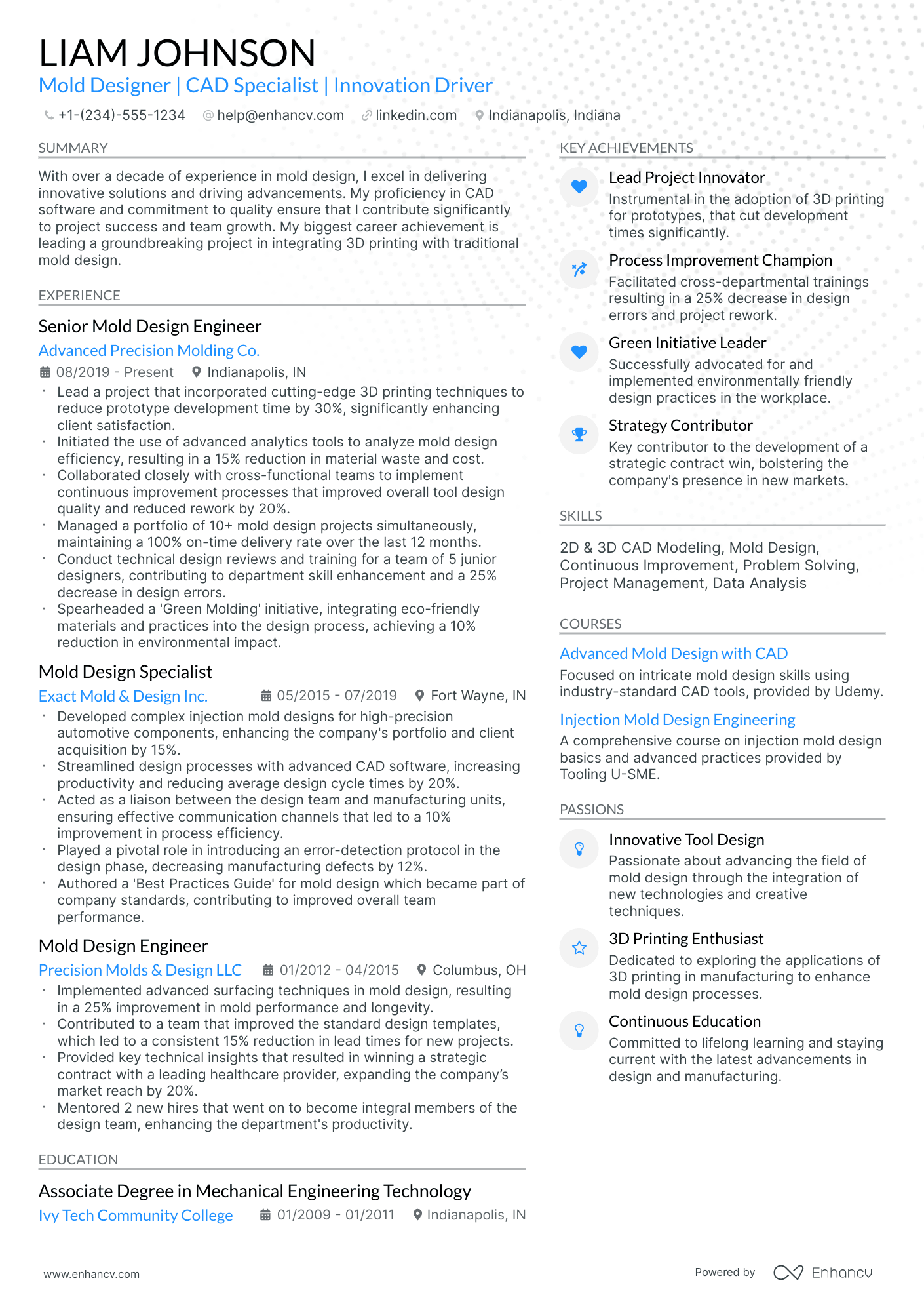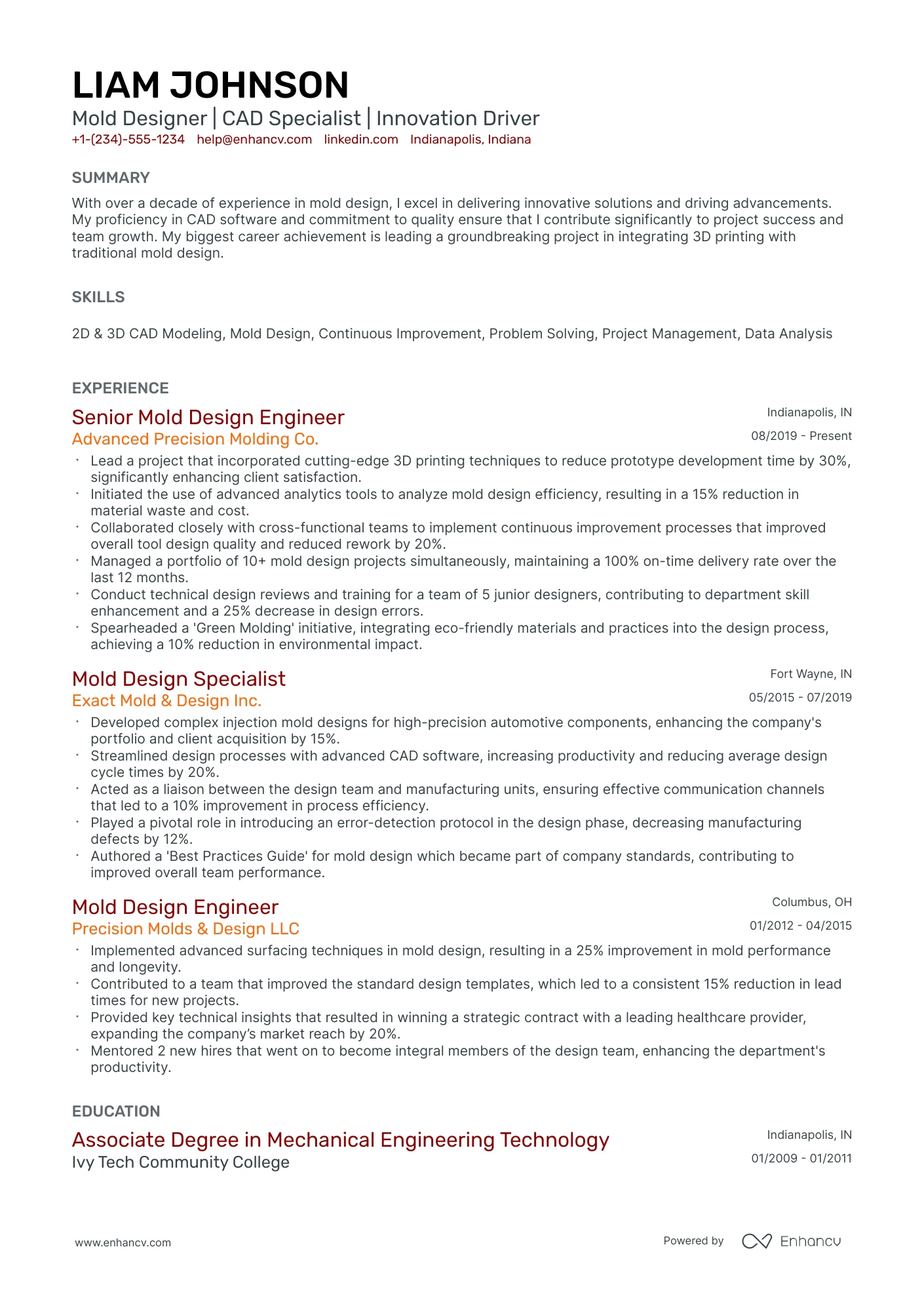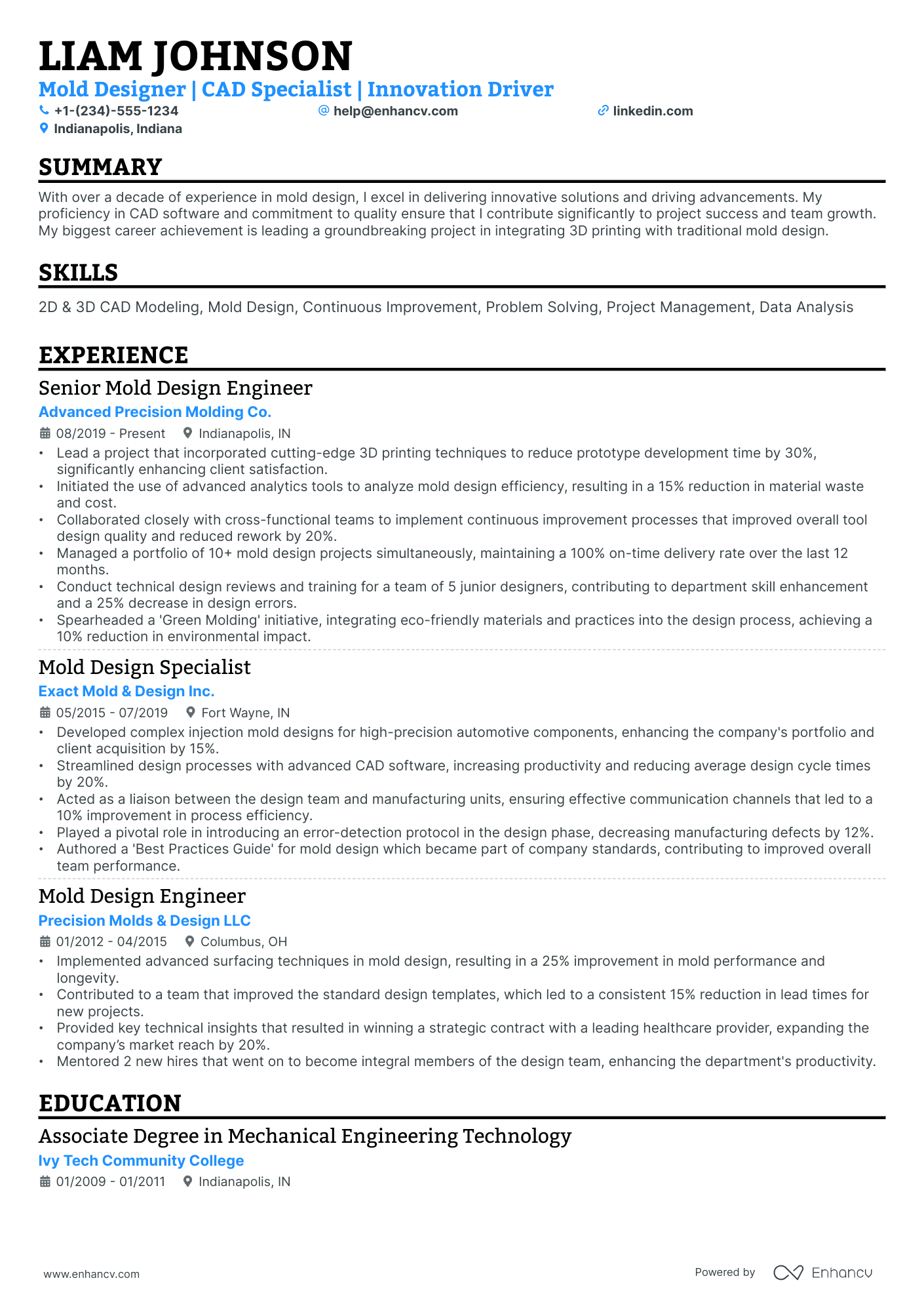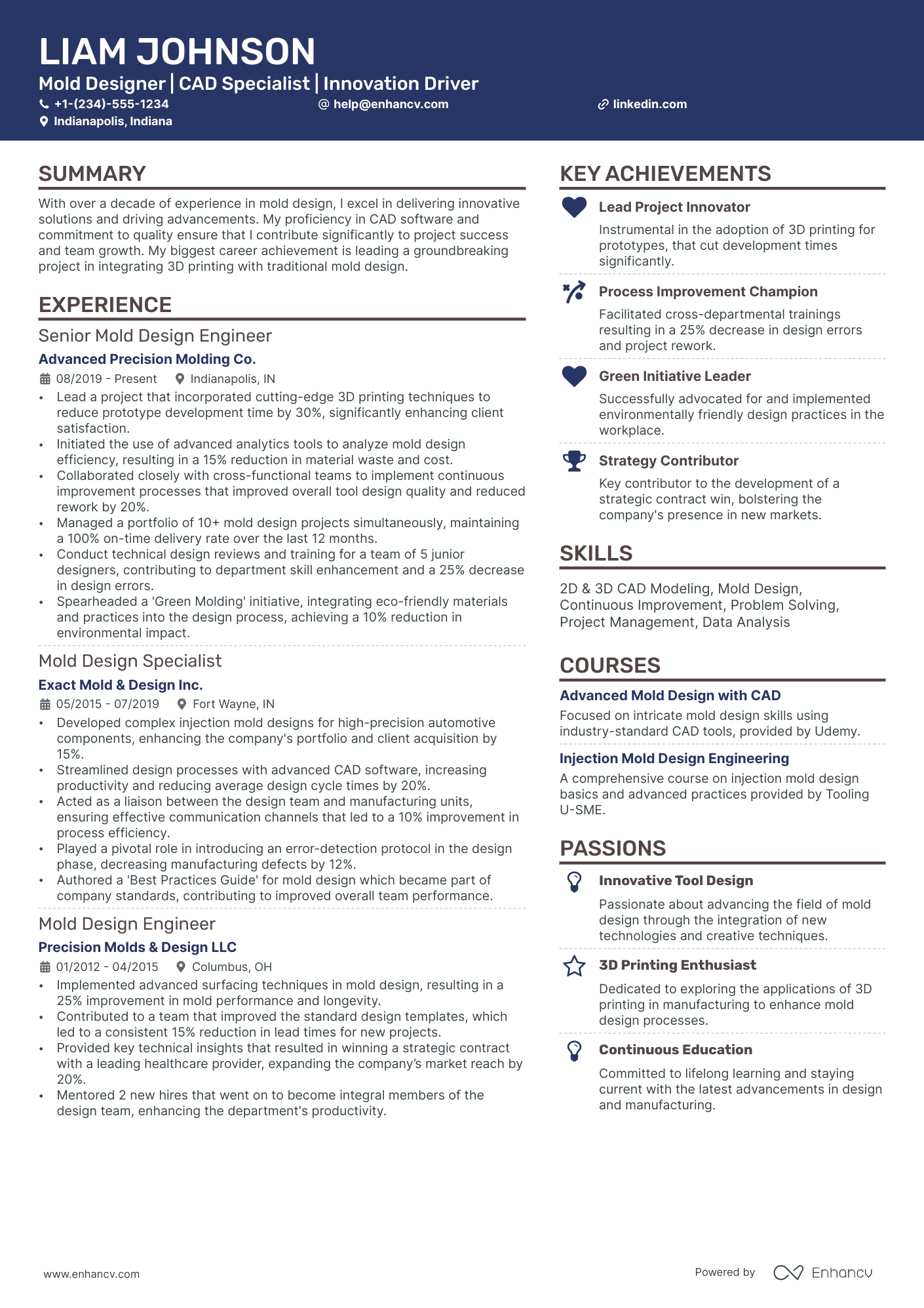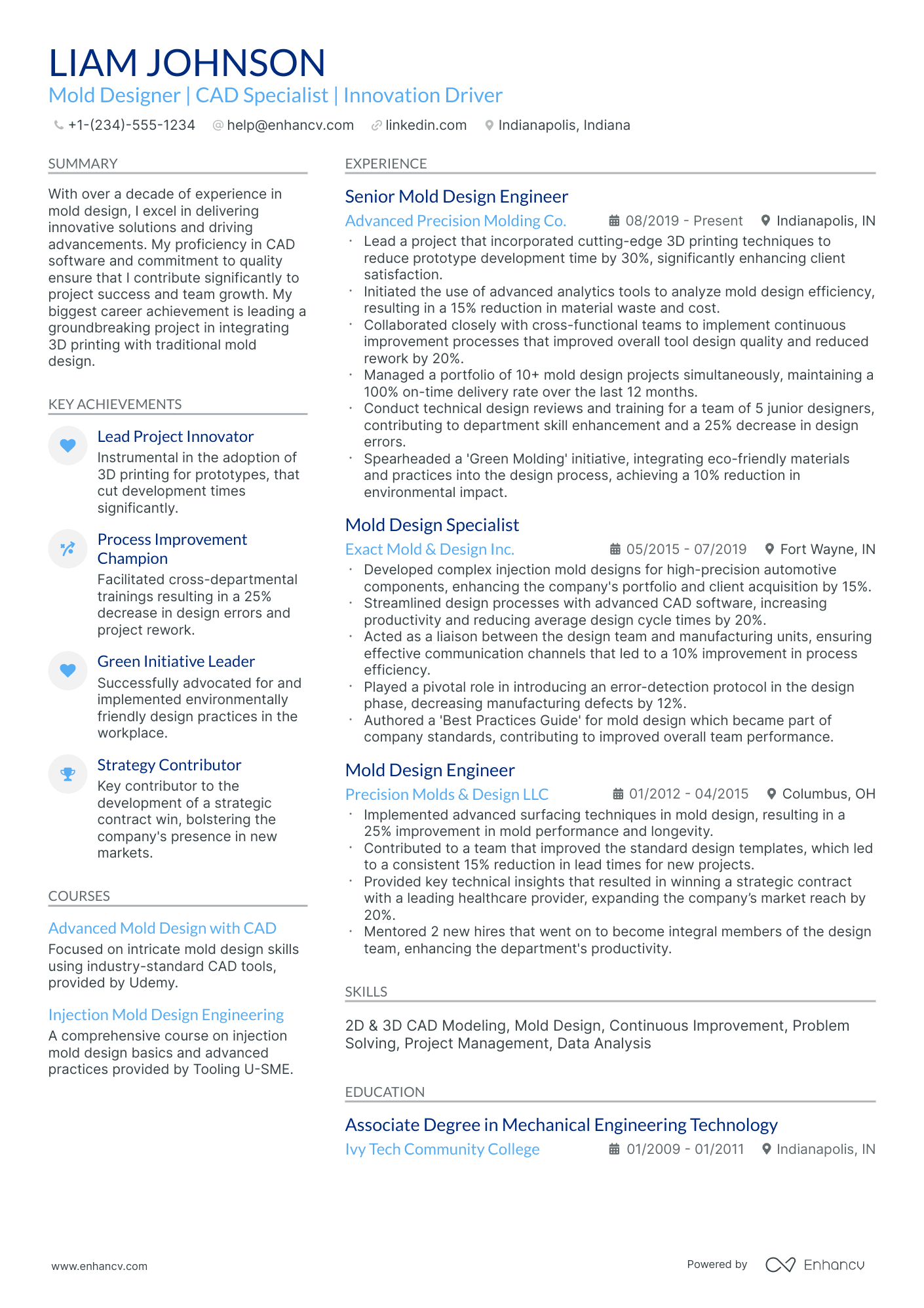As a mold designer, it can be challenging to effectively showcase the complexity of your projects and the precision skills you've acquired. Our guide offers clear strategies to help you articulate these intricate details, ensuring your resume stands out to potential employers.
- Defining the highlights of your mold designer career through your resume summary, objective, and experience.
- Real-world mold designer resume samples with best practices on how to stand out amongst the endless pile of candidate resumes.
- Most in-demand mold designer resume skills and certifications across the industry.
- Standardizing your resume layout, while maintaining your creativity and individuality.
If the mold designer resume isn't the right one for you, take a look at other related guides we have:
- Kitchen Designer Resume Example
- Digital Designer Resume Example
- Jewelry Designer Resume Example
- CAD Designer Resume Example
- Curriculum Designer Resume Example
- Design Manager Resume Example
- Brand Designer Resume Example
- Creative Director Resume Example
- Associate Creative Director Resume Example
- Electrical Designer Resume Example
The importance of format and layout in your mold designer resume
Consider you're an HR professional at company X, evaluating two mold designer candidate resumes. John Smith presents a simple, traditional, and easy-to-read resume. Edward Price, however, uses a non-conventional, often illegible format. Whose resume would you spend more time on to understand their experience? This scenario underscores the importance of your mold designer resume’s design. It should be simply formatted and clearly communicate why you are the ideal candidate for the role.
Achieve this balance by:
- Listing your experience, beginning with the most recent and relevant, in reverse chronological order;
- Ensuring your header contains essential information, such as contact details, a headline, and a portfolio link. Include a professional photo in the mold designer resume header if you have one;
- Including only the most important and relevant resume sections to showcase your expertise and stand out from other candidates;
- Editing your mold designer resume to be no longer than two pages if you have extensive relevant experience. Use your limited resume space judiciously.
Also, remember that your mold designer resume might initially be scanned by an Applicant Tracker System (ATS).
When it comes to ATS:
- Opt for simple and legible fonts like Raleway, Rubik, Lato, etc., making your experience easy for the ATS to scan;
- Use serif and sans-serif fonts, both of which are ATS-friendly;
- Avoid overused options like Arial and Times New Roman, which, while suitable, may lack personality.
Contrary to a common myth, our recent study shows that the ATS can effectively process both one-column and two-column resumes. Learn more about this in the ATS myths guide.
Finally, when submitting your mold designer resume, always export it as a PDF to ensure all information remains intact, making the document easier to print, read, and scan.
Adjust your resume layout based on the market – Canadian resumes, for example, may follow a unique format.
Upload & Check Your Resume
Drop your resume here or choose a file. PDF & DOCX only. Max 2MB file size.
PRO TIP
Listing your relevant degrees or certificates on your mold designer resume is a win-win situation. Not only does it hint at your technical capabilities in the industry, but an array of soft skills, like perseverance, adaptability, and motivation.
Mold designer resume sections to answer recruiters' checklists:
- Header to help recruiters quickly allocate your contact details and have a glimpse over your most recent portfolio of work
- Summary or objective to provide an overview of your career highlights, dreams, and goals
- Experience to align with job requirements and showcase your measurable impact and accomplishments
- Skills section/-s to pinpoint your full breadth of expertise and talents as a candidate for the mold designer role
- Education and certifications sections to potentially fill in any gaps in your experience and show your commitment to the industry
What recruiters want to see on your resume:
- Proficiency in mold design software (such as SolidWorks, AutoCAD, or CATIA) and 3D CAD modeling
- Experience with plastic injection molding processes and mold-making techniques
- Knowledge of mold materials, component standards, and design principles for manufacturability and maintenance
- Understanding of quality control measures and ability to implement design changes to improve product quality
- Experience with troubleshooting mold issues and proposing practical solutions
Quick guide to your mold designer resume experience section
After deciding on the format of your resume, it's time to organize your experience within the dedicated section.
It's common for mold designer professionals to be confused in this part of the process, as they may have too much or little expertise.
Follow the general rules of thumb to be successful when writing this part of your resume:
- The perfect number of bullets you should have under each experience item is no more than six;
- Select not merely your responsibilities, but the most noteworthy achievements for each role that match the job requirements;
- List any certificates or technical expertise you've gained on the job and how they've helped you progress as a professional;
- Carefully select the power verbs to go along with each bullet to avoid generic ones like "managed" and instead substitute those with the actuality of your particular responsibility;
- Integrate valuable keywords from the job advert in the form of achievements under each role you list.
If you're on the search for further advice on how to write your mold designer experience section, get some ideas from real-world professional resumes:
- Developed complex mold designs for automotive components, leading to a 30% reduction in part warpage and improved product quality.
- Spearheaded the implementation of 3D CAD modeling using SolidWorks, enhancing design accuracy and efficiency for a team of 10 designers.
- Collaborated with cross-functional teams, including production and quality assurance, to incorporate design changes that reduced mold fabrication time by 20%.
- Managed a portfolio of over 50 custom injection mold designs for the medical devices sector, adhering to strict FDA regulations and achieving a 99.8% acceptance rate.
- Initiated a peer review process that improved design accuracy by 25% and fostered a collaborative team environment.
- Negotiated with material suppliers to reduce costs by 15%, while maintaining high standards of quality in mold designs.
- Served as a crucial team player in a project to design and manufacture high-precision molds for aerospace components, resulting in a prestigious industry award for innovation.
- Enhanced the mold design process through the introduction of simulation software, leading to a 40% improvement in mold trial success rates.
- Guided juniors designers through complex design challenges, thereby increasing the team's output by 20% without compromising on quality.
- Created and patented a novel mold design for consumer electronics which streamlined the manufacturing process and was adopted by the entire product line.
- Conducted comprehensive workshops on advanced mold design technologies for the design department, enhancing team capabilities and knowledge.
- Drove significant improvements in mold lifespan and maintenance, increasing operational uptime by 30% and reducing maintenance costs by 25%.
- Orchestrated a company-wide transition to a new CAD system for mold design, resulting in a 35% decrease in average design time per project.
- Actively contributed to the design of eco-friendly molds that minimized waste by 15%, supporting the company’s sustainability objectives.
- Played a pivotal role in the upgrade of our mold fabrication workshop, increasing production capacity by 50%.
- Innovated the use of composite materials in mold designs for the sports equipment industry, yielding a 20% improvement in product performance.
- Developed precise molds for high-tolerance requirements, with an error margin of less than 0.01%, ensuring exceptional product quality and client satisfaction.
- Oversaw the department's budget, reducing operational expenses by 10% while maintaining high standards of design quality and precision.
- Integrated advanced flow analysis into mold designs for packaging products, leading to a 50% reduction in plastic use and support for the company's green initiative.
- Provided integral design solutions that increased molds' production speed by 35%, significantly cutting down the time to market for new products.
- Mentored four junior mold designers, developing their skills in advanced design techniques which increased department productivity by 25%.
- Revolutionized the design of modular molds for toys manufacturing, allowing for versatile product line expansions and a 40% faster prototype development.
- Established a data-driven approach to analyze mold performance post-production, using the insights to optimize designs and reduce raw material consumption by 18%.
- Directly engaged with key clients to understand their customization needs, enhancing customer happiness index scores by 22% through personalized mold solutions.
The following content includes information from "O*NET OnLine" by the U.S. Department of Labor, Employment and Training Administration (USDOL/ETA). Used under the CC BY 4.0 license. The data represents the top responsibilities present on the task lists for mold designer professionals.
Top Responsibilities for Mold Designer:
- Develop detailed design drawings and specifications for mechanical equipment, dies, tools, and controls, using computer-assisted drafting (CAD) equipment.
- Produce three-dimensional models, using computer-aided design (CAD) software.
- Lay out and draw schematic, orthographic, or angle views to depict functional relationships of components, assemblies, systems, and machines.
- Modify and revise designs to correct operating deficiencies or to reduce production problems.
- Review and analyze specifications, sketches, drawings, ideas, and related data to assess factors affecting component designs and the procedures and instructions to be followed.
- Check dimensions of materials to be used and assign numbers to the materials.
- Design scale or full-size blueprints of specialty items, such as furniture and automobile body or chassis components.
- Compute mathematical formulas to develop and design detailed specifications for components or machinery, using computer-assisted equipment.
- Coordinate with and consult other workers to design, lay out, or detail components and systems and to resolve design or other problems.
- Confer with customer representatives to review schematics and answer questions pertaining to installation of systems.
Quantifying impact on your resume
- Include the number of mold design projects completed to showcase experience and productivity.
- Specify the percentage of designs that passed quality checks on the first submission to demonstrate accuracy and adherence to standards.
- Highlight the reduction in material costs achieved through innovative mold design to show cost-saving skills.
- Mention the decrease in production time due to efficient mold designs to illustrate time management and process improvement capabilities.
- Quantify the scale of mold designs by including the size of the molds or the volume of production runs to indicate experience with large or complex projects.
- State the number of design revisions needed before final approval to reflect strong initial design skills and minimal rework.
- List any increases in client satisfaction rates or repeat business secured as a result of your mold designs to portray customer service and reliability.
- Present any awards or recognitions received for mold designs to underscore peer or industry acknowledgement of expertise.
Action verbs for your mold designer resume
What to do if you don't have any experience
It's quite often that candidates without relevant work experience apply for a more entry-level role - and they end up getting hired.
Candidate resumes without experience have these four elements in common:
- Instead of listing their experience in reverse-chronological format (starting with the latest), they've selected a functional-skill-based format. In that way, mold designer resumes become more focused on strengths and skills
- Transferrable skills - or ones obtained thanks to work and life experience - have become the core of the resume
- Within the objective, you'd find career achievements, the reason behind the application, and the unique value the candidate brings about to the specific role
- Candidate skills are selected to cover basic requirements, but also show any niche expertise.
Recommended reads:
PRO TIP
Bold the names of educational institutions and certifying bodies for emphasis.
Defining your unique mold designer skill set with hard skills and soft skills
In any job advertisement, a blend of specific technologies and interpersonal communication skills is typically sought after. Hard skills represent your technical expertise and indicate your job performance capacity. Soft skills, on the other hand, demonstrate how well you would integrate within the company culture.
Incorporating a balanced mix of both skill types in your mold designer resume is crucial. Here's how you can do it:
- In your resume summary or objective, incorporate up to three hard and/or soft skills. Make sure to quantify these skills with relevant or impressive achievements; less
- The skills section should list your technical know-how.
- The strengths section is an ideal place to quantify your competencies by focusing on the achievements facilitated by these skills.
Top skills for your mold designer resume:
CAD Software (e.g., SolidWorks, AutoCAD)
3D Modeling
Mold Flow Analysis
Injection Molding Techniques
Materials Science
Prototyping
CAM Software
Tool Design
Surface Modeling
Project Management Software
Problem-Solving
Attention to Detail
Creativity
Communication
Team Collaboration
Time Management
Adaptability
Critical Thinking
Analytical Skills
Organizational Skills
Next, you will find information on the top technologies for mold designer professonals from "O*NET OnLine" by the U.S. Department of Labor, Employment and Training Administration (USDOL/ETA). Used under the CC BY 4.0 license.
Top technologies for Mold Designer’s resume:
- Autodesk AutoCAD Civil 3D
- Autodesk Revit
- Microsoft PowerPoint
- Adobe After Effects
- Trimble SketchUp Pro
PRO TIP
List your educational qualifications and certifications in reverse chronological order.
Listing your education and certifications on your mold designer resume
Don't underestimate the importance of your resume education section . As it may hint at various skills (and experience) that are relevant to the job. When writing your education section:
- Include only higher education degrees with information about the institution and start/end dates
- If you're in the process of obtaining your degree, include your expected graduation date
- Consider leaving off degrees that aren't relevant to the job or industry
- Write a description of your education if it presents you with an opportunity to further showcase your achievements in a more research-focused environment
When describing your certifications on your resume, always consider their relevancy to the role. Use the same format to describe them as you would for your education. If you're wondering what the best certificates out there are for mold designer roles, check out the list below.
The top 5 certifications for your mold designer resume:
- Certified mold designer (CMD) - American Mold Builders Association (AMBA)
- Certificate in Mold Design (CMD) - Society of Plastics Engineers (SPE)
- Certified SolidWorks Professional - Mold Making (CSWP-MM) - Dassault Systèmes SolidWorks Corporation
- Master Moldmaker (MM) - Society of Manufacturing Engineers (SME)
- Certified Plastic Injection mold designer (CPIMD) - Routsis Training
The content below includes information from "O*NET OnLine" by the U.S. Department of Labor, Employment and Training Administration (USDOL/ETA). Used under the CC BY 4.0 license. The data represents the top associations for mold designer professionals.
Top US associations for a Mold Designer professional
- Accrediting Commission of Career Schools and Colleges
- American Design Drafting Association
- Society of Manufacturing Engineers
PRO TIP
Mention specific courses or projects that are pertinent to the job you're applying for.
Recommended reads:
Writing the mold designer resume summary or objective: achievements, keywords, dreams, and more
Deciding on whether to include a resume summary or resume objective should entirely depend on your career situation.
If you have:
- Plenty of relevant achievements you'd like to bring recruiters' focus to, make use of the resume summary. Ensure each of your achievements is quantified with concrete proof (e.g. % of cases solved).
- Less applicable experience, utilize the resume objective. Within the objective include a few noteworthy, past successes, followed up by your professional dreams.
As a bonus, you could define in either your mold designer resume summary or objective what makes you the perfect candidate for the role.
Think about your unique hard and soft skills that would make your expertise even more important to the job.
These mold designer professionals have completely covered the formula for the ideal resume introduction:
Resume summaries for a mold designer job
- With over a decade of expertise in mold design for the automotive industry, this candidate brings a profound ability to create detailed, high-quality designs using SolidWorks and AutoCAD. Recognized for leading a team that achieved a 30% reduction in production time through design optimization, the applicant ensures efficiency and precision in complex projects.
- Former aerospace engineer with 8 years of experience in precision component design, seeking to leverage extensive knowledge of materials science and 3D modeling in transitioning to mold design. The aim is to apply rigorous testing methodologies to enhance mold longevity and performance in a new sector.
- Highly accomplished mold designer with 15 years at the helm of creating innovative plastic injection molds for consumer electronics, adept in employing Mastercam and Moldflow. Notable for introducing an ergonomic mold design that led to a patented product and a 25% increase in manufacturing productivity.
- An experienced mechanical engineer with a passion for creative problem-solving and a history of successful project management intends to transition into mold design. Eager to apply analytical skills and knowledge in material behavior to develop efficient and reliable molds for high-volume manufacturing processes.
- Aspiring to begin a career in mold design, this enthusiastic individual comes with a strong foundation in mechanical engineering principles, including coursework in CAD and material science. Driven by a passionate commitment to mastering new technologies and eager to contribute to creating groundbreaking molds for industry-leading products.
- With a fresh perspective and a solid grounding in industrial design principles, this recent graduate seeks to specialize in mold design. Determined to learn from seasoned professionals and leverage academic knowledge of product development cycles and 3D printing to excel in creating innovative and cost-effective mold solutions.
Average salary info by state in the US for mold designer professionals
Local salary info for Mold Designer.” Source: My Next Move, National Center for O*NET Development. Accessed 10/15/2024
| State | Average Salary (in USD) |
|---|---|
| US National Average | $64,060 |
| California (CA) | $78,610 |
| Texas (TX) | $68,070 |
| Florida (FL) | $51,800 |
| New York (NY) | $69,990 |
| Pennsylvania (PA) | $60,460 |
| Illinois (IL) | $67,920 |
| Ohio (OH) | $63,320 |
| Georgia (GA) | $61,680 |
| North Carolina (NC) | $60,400 |
| Michigan (MI) | $63,570 |
Recruiters' favorite additional mold designer resume sections
When writing your mold designer resume, you may be thinking to yourself, " Is there anything more I can add on to stand out? ".
Include any of the below four sections you deem relevant, to ensure your mold designer resume further builds up your professional and personal profile:
Key takeaways
- The logic of your resume presentation should follow your career highlights and alignment with the role;
- Curate information within different sections (e.g. summary, experience, etc.) that helps highlight your strengths;
- Exclude from your resume irrelevant experience items - that way you'd ensure it stays no longer than two pages and is easy to read;
- Dedicate space within the summary, experience, and/or achievements to highlight precisely why you're the best candidate for the role via your previous success;
- Both your technical and people capabilities should also play a crucial role in building up your mold designer application. Prove your skill set in various resume sections.
